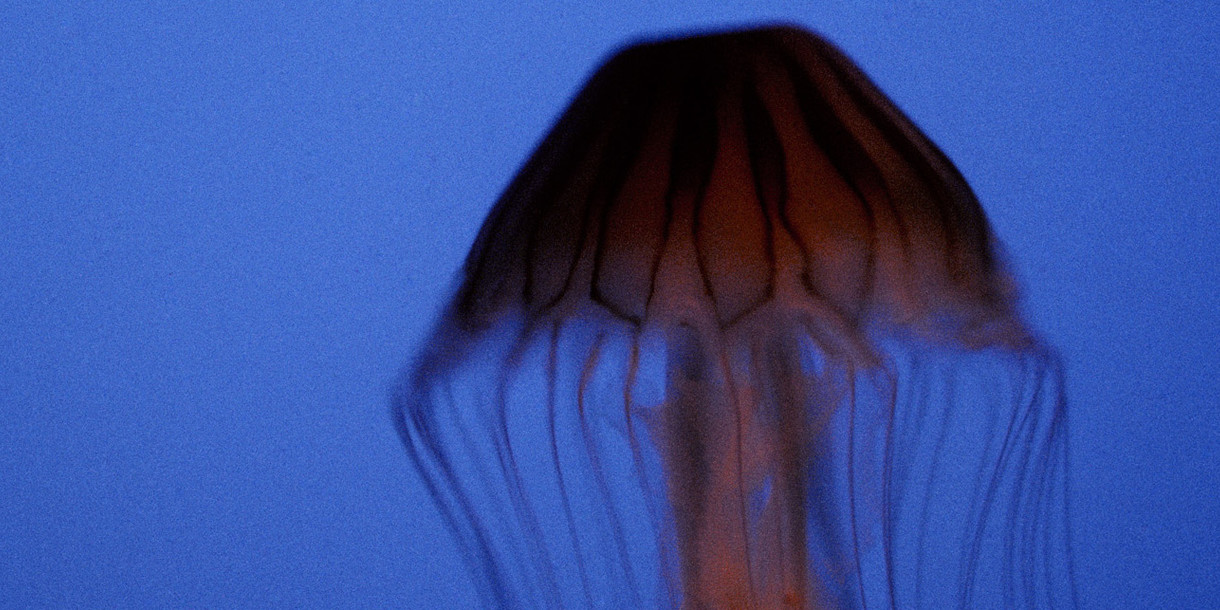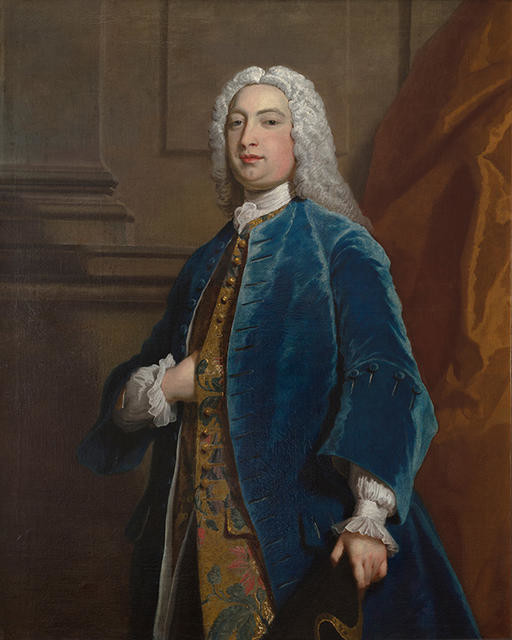Success to Excess
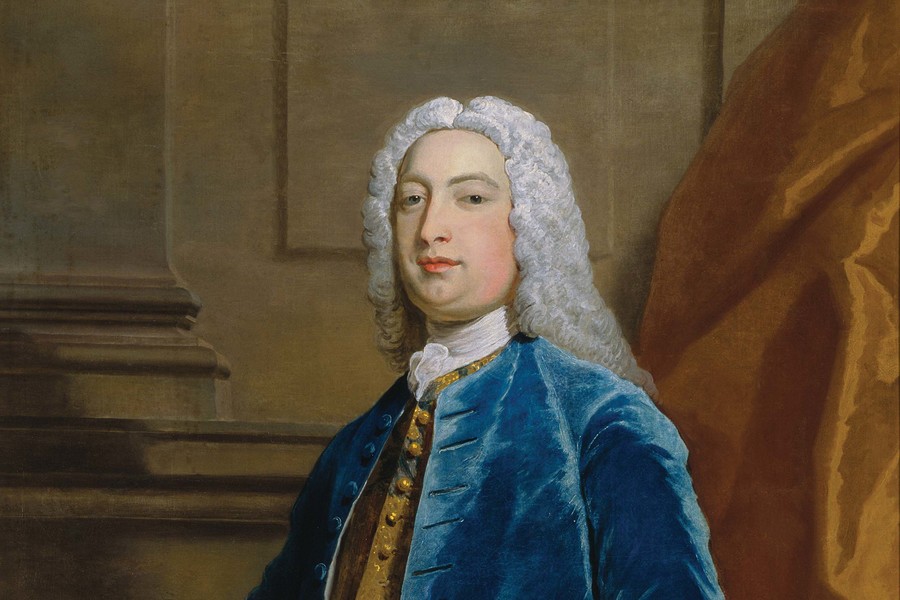
Joseph Highmore Thomas Budgen, Esq., M.P. for Surrey 1751–61 (detail) 1735. Oil on canvas. Collection of Christchurch Art Gallery Te Puna o Waiwhetū, purchased 1977
Several early British portraits in the Gallery’s collection depict sitters whose identity is as yet unknown; pleasingly, their number has been reduced in recent years. One painting in particular—previously titled Portrait of a Gentleman in a Blue Jacket and Embroidered Waistcoat — is greatly enriched by having the story of a specific human life attached to it. It is also unexpectedly linked to other portraits in the collection.
Resplendent in his tailored embroidery, yards of blue velvet and gleaming wig, this early eighteenth-century English gentleman displays a full measure of status, wealth and success. Painted in 1735 by Joseph Highmore (1692–1780), everything about the portrait asserts refinement and means; it is exactly how the sitter wanted to be seen. But how had his identity become separated from his splendid likeness? The records show that the portrait entered the collection in 1977, having been purchased from an Invercargill watchmaker who bought it in England (several similar purchases were made from this source at the same time). It was then in poor condition, with numerous repairs and tears, over-painting and other damage, and erroneously attributed to Thomas Hudson. However, in preparation for the opening of the new Gallery in 2003, the portrait received extensive conservation treatment and Highmore’s signature and a date were discovered at lower left. Reframed and re-varnished, it responded well to being readied for display.
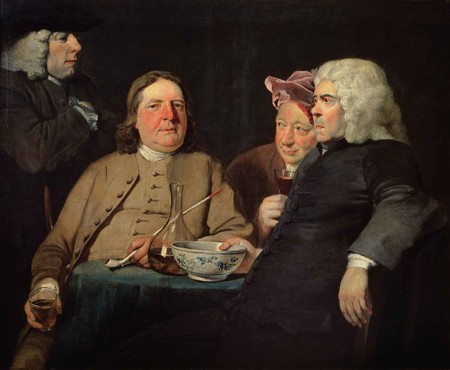
Joseph Highmore Mr Oldham and his guests c.1735–45. Oil on canvas. Tate Britain, purchased 1948 N05864
In 1735, Joseph Highmore was one of London’s leading portrait painters, in demand for his elegant and highly accomplished style. Highmore had visited Antwerp in 1732 and Paris in 1734, particularly seeking out the work of Rubens and van Dyck – their influence is seen here in a lightened palette, rococo elements and consciously stylish pose. Highmore is reputed to have painted his subjects’ faces in a single session – the critic George Vertue noted, ‘ Mr. Highmore paints much, & the faces often at one Sitting as much finisht. as he can – never touches any more.’1 Evidence of his skill at character study is displayed in one of his best-known works, the group portrait Mr Oldham and his guests (c.1735–45), which includes a self-portrait at top left. One could stand before the Gallery’s portrait, however, and despite enjoying the bravura paintwork on the dazzling costume and curling wig, reflexively dislike the subject for his calmly superior reserve. Highmore was an expressive painter, but this face is almost a mask.
Wondering if we might ever identify the sitter, contact was made with Dr Alison Lewis, an American art historian who studied Highmore in the 1970s; she was able to produce an archival photograph of our portrait taken in 1955, at that time in a private collection in Edinburgh, and a name.2 Thomas Budgen’s story could finally be returned to his likeness.
Thomas Budgen and his kin left behind a trail of published and unpublished references that piece together to tell a broader tale. A note that he had been a Member of Parliament for Surrey was a useful starting point. Born into a prominent Surrey family, Thomas was the fourth of five sons of Edward Budgen, high sheriff of Surrey in 1698–9, who lived at Newdigate Place near Dorking (the seat of the Budgen family since 1636) and died in 1719.3 The five brothers, Edward, John, James, Thomas and William, were educated at Oxford, where John and William both died of smallpox.4 Thomas’s surviving brothers Edward and James entered into law, prospered and married well. Taking a different course, Thomas established himself as a sugar baker in London – it may be assumed as an owner investor rather than hands-on refiner; the refining process was profitable, but laborious, swelteringly hot and often dangerous. Tea consumption soared in the opening decades of the eighteenth century and was matched by a growing taste for sugar, grown on British-owned plantations in the West Indies and refined in England. Thomas entered this business in around 1726 while in his early twenties; his large sugarhouse in Buckle Street, Whitechapel was insured for £1,500 in that year, and remained in his ownership for the next twenty years.5 Tidying his affairs in Surrey, Thomas moved to London at around this time; on 18 March 1727 the London Evening Post advertised:
To be LET. At Dorking in Surrey, 20 Miles from London, 10 from Guildford and 7 from Epsom, a House of four Rooms on a Floor, a large Garden wall’d in, and planted with very good Fruit, with Brew-house, Cellers, Coach house and Stabling for six Horses, Enquire of Dr. Budgen at Dorking aforesaid, or of Mr. Tho. Budgen, Sugar Baker in Goodman’s Fields, London.
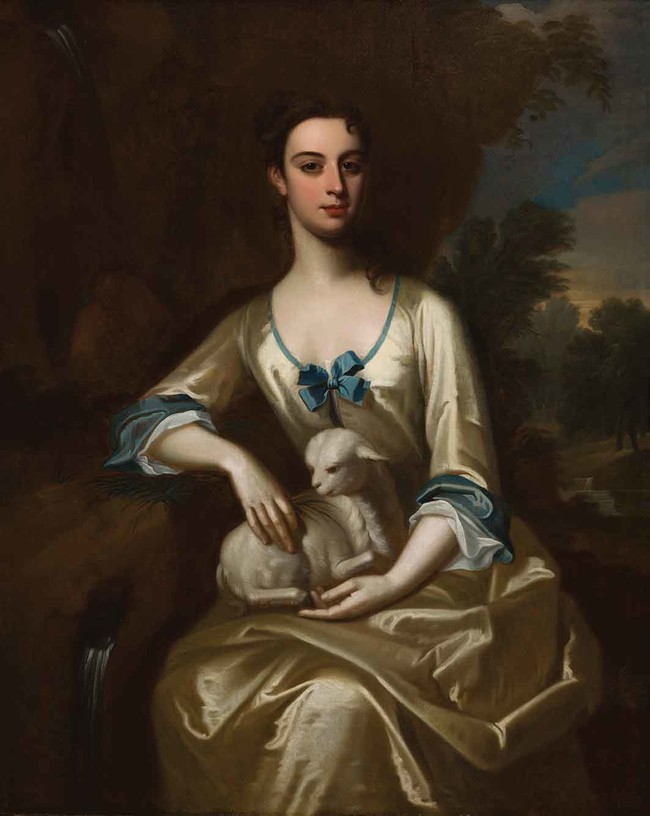
Maria Verelst (attributed to) Portrait of Penelope Smith c.1727. Oil on canvas. Collection of Christchurch Art Gallery Te Puna o Waiwhetū, purchased 1977
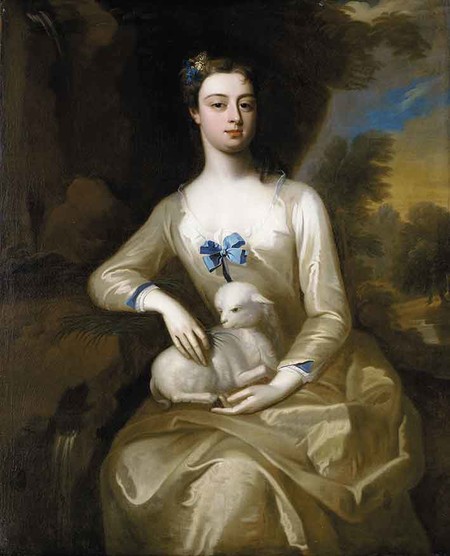
Maria Verelst (circle of) Portrait of a lady undated. Oil on canvas. Private collection. Photo © Christie’s Images / The Bridgeman Art Library
Next came marriage. On Saturday 28 October 1727, it was reported that ‘On Thursday last Mr. Budgen, a SugarBaker in Goodmans Fields was marry’d at the Temple Church to Mrs [sic] Penelope Smith of St. Andrew’s, Holbourn, a Gentlewoman of a very great Fortune.’6 The name of Budgen’s wife brought to mind another portrait in the Gallery collection, of a young woman holding a somewhat mutant lamb; it too had come from Invercargill and was also (wrongly) attributed to Hudson. A hidden label on the back provided good information: ‘Penelope 2nd Daughter of D Smith Esq. Governor / of Nevis married Oct 26th 1727 Thomas Budgen Esq. / MP for Surrey in the reign of George 2nd / died Aug 10th 1773 & was buried in / Dorking Church.’ The paintings belonged together. This, then, was an engagement or marriage portrait, and the lamb a symbol of bridal purity. As a daughter and heiress of Daniel Smith, governor of the island of Nevis in 1712–22, Penelope also had Caribbean connections, with strong links to Britain’s dependence on sugar and slavery. Six days before the wedding, Thomas entered into a business contract with his uncle, Dr John Budgen of Dorking, and the London merchants Thomas Butler and William Coleman, investing a significant sum in a plantation on Nevis, with ‘Negroes, Stock and Utensils belonging thereto’.7 Thomas and Penelope were ideally matched, and with guaranteed means for increasing profit.
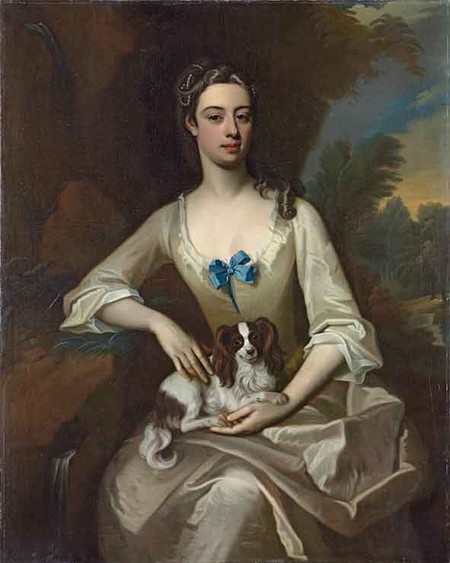
Maria Verelst (attributed to) Portrait of a lady undated. Oil on canvas. Private collection. Photo © Christie’s Images / The Bridgeman Art Library
Penelope’s portrait is conventional; a little outmoded for its time, it closely matches works attributed to Maria Verelst (1680–1744) and Enoch Seeman (c.1694–1744), whose œuvre are not yet well understood or established.8 Penelope’s face is moderately well painted, but her head and neck are awkwardly joined; most of the painting is by a faster, possibly different hand. The discovery of two near-identical portraits sold through Christie’s, London (both attributed to Verelst) suggests everything but the head had been pre-prepared.
Despite her family’s wealth, Penelope’s rather conservative portrait is in keeping with her position in London society at this time. Her parents, first cousins, were third-generation plantation owners on Nevis, so wealth was just beginning to transform the family’s status. Her maternal grandfather William Mead (d.1704) was governor of St Kitts from 1698 to 1701, and her father Daniel Smith (1667–1722) governor of Nevis for ten years from 1712. Both branches of Penelope’s family had vast plantations on St Kitts and Nevis: during a turbulent period in 1707, her father and her maternal grandmother Penelope Mead were recorded as owning 200 slaves on St Kitts (including forty-four children, probably not Penelope’s playmates); her father also had twenty-two adult slaves on Nevis.9 Settling in London in his early fifties, Lieutenant-Governor Daniel Smith of Nevis died in 1722 at his home at Leicester Street, St Anne, Westminster.10 (The family’s address was just seven minutes’ walk to Maria Verelst’s studio in Suffolk Street or three minutes’ leisurely stroll to Enoch Seeman’s in St Martin’s Lane.)
‘The Budgens, Smiths and Webbs were part of the same world. The West Indies were a tempestuous tropical garden for British families on the make, outnumbered by their human chattels...’
Upon reaching twenty-one, Penelope inherited £2,000 from her father’s estate, probably shortly before her marriage. Thomas was a sort of money magnet, with further riches showering upon him between 1728 and 1732 through the demise of others including his two remaining brothers. Edward (born c.1699) ‘of Sutton in Surrey, a Gentleman in the Commission of the Peace’ died of fever at his house in Southampton Row on 12 August 1728 (London was facing a typhus epidemic; their mother Elizabeth, née Ede, also died of smallpox in the following month).11 Edward had married an extremely wealthy heiress, and also inherited Leigh Place, an ancient farm of 126 acres near Reigate, from the death of a great-uncle in 1716.12 The great-uncle’s will directed Edward’s property and wealth to Thomas’s next eldest brother, James, ‘a Surrey Gentleman’ and Trinity College, Oxford graduate who in August 1729 had made a fine marriage to ‘a Gentlewoman of a considerable Fortune’.13 Following his death in 1732, Thomas again inherited:
Yesterday died, at his House in Norfolk-street in the Strand, James Budgen, Esq, Counsellor of the Temple, a Gentleman about thirty-two Years of Age: He died without Issue; so that a large Estate falls to his only surviving Brother, Mr. Thomas Budgen, an eminent Sugar-Baker in Goodman’s-Fields.14
In 1733, through the death of Edward’s widow (who had remarried ‘an ancient gentleman, an Attorney at Law’ in 1729), Thomas inherited an additional £400 per annum.15 Thomas retained his sugarhouse in Whitechapel (maintaining a hefty land tax on the property from 1733 to 1746) but others managed its operation from 1733.16 By 1734, his public status was ‘Gentleman’ rather than sugar baker. In 1735, when Joseph Highmore painted his portrait, he had money to spend on art.17
Thomas dipped his toes into political waters in September 1738, ambitiously lining himself up for election as MP for Reigate, Surrey. His uncle, Dr Budgen, entreated his friend the Duke of Richmond to seek favour from the Lord Chancellor on Thomas’s behalf, but his plans faltered; several months into the campaign his candidacy was withdrawn. The death of his uncle was reported on 7 June 1740: ‘ Last week died at Darking in the County of Surrey, Dr. Budgen, an eminent Physician, who has lived many Years there, and died very rich.’18 Adequate provision was made for his widow; they had no children and Thomas became the principal heir, inheriting family property including Newdigate Place.19 Thomas and Penelope Budgen at this time lived on the leafy edges of London in ‘ Bedford Row in the Parish of Saint Andrew Holborn in the County of Middlesex’.
The Budgens had two children, John Smith Budgen (1741– 1805) and Penelope Budgen. In August 1741, six weeks after the birth of their son, Thomas stepped up his dealings on Nevis, entering into a joint lease on a plantation in partnership with Penelope's brother, Daniel Smith, and three others (1741 records show Budgen as the owner of this or another plantation of some 150 acres).20 His brother-in-law had entered the Council for the Leeward Islands in 1727.21 Coincidentally, he sat on the council for the next twelve years with Nathaniel Webb, whose portrait was given to the Gallery in 2007 by a descendant. Somerset-born Webb was collector of customs on nearby Montserrat for twenty years from 1720, and is recognised as a notorious slave trader, who reaped vast returns through the sale of enslaved Africans (records of slave imports to Montserrat in 1721–9 show he was consigned nine out of a total of nineteen cargoes, and 1,268 out of a total of 3,210 individuals brought from Africa).22 His tale will someday require its own telling.
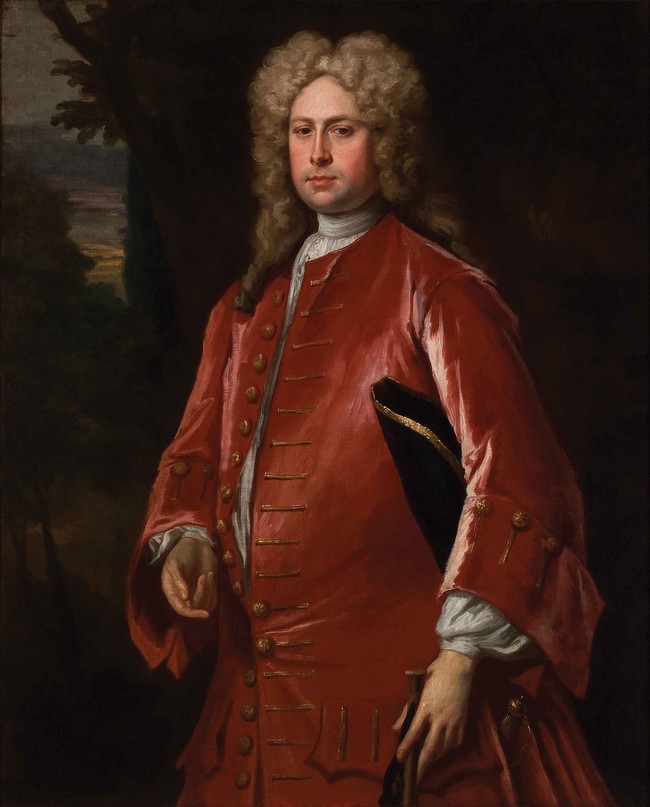
Unknown artist Nathaniel Webb, Esq., of Roundhill Grange, Charlton Musgrove, Somerset c.1715. Oil on canvas. Collection of Christchurch Art Gallery Te Puna o Waiwhetū, presented by Mrs Sally Fox in memory of her father John Jekyll Cuddon 2007
The Budgens, Smiths and Webbs were part of the same world. The West Indies were a tempestuous tropical garden for British families on the make, outnumbered by their human chattels, who were stripped of dignity and counted alongside beasts. The slave trade brought at least ten million Africans to the Americas, most in the eighteenth century, with a high proportion to the West Indies for the production of sugar, molasses and rum. In 1749, Thomas Budgen leased a property called Smith’s Plantation to Edward Jesup. Southampton Archives Office holds a ‘ List of Negroes belonging to the Estate of Edward Jesup Esq., 17 June 1748’ and documents of ‘Conveyance (lease and release): Thomas Budgen to Edward Jesup, Smith ’s Plantation in Nevis; June 14, 15, 1749’. It is possible that Budgen never travelled to Nevis in person but remained in England, the archetypal absentee landlord.
Still prizing politics, he entered the House of Commons on 14 May 1751: ‘ Thomas Budgen, Esq; lately chosen Knight of the Shire for the County of Surry, took his Seat in the House of Commons’, a week after the election.23 Regarded by now a ‘country gentleman’, Budgen also returned unopposed in 1754, in the general election that for its farcical campaigning inspired William Hogarth’s satirical An Election series. Budgen intended to stand again in 1761, had support from the Duke of Newcastle (who became Prime Minister), and was approved ‘without any ostensible opposition’. At the county meeting, however, ‘after the desertion of some former friends’ he faced ‘great discontent and dissatisfaction’ at his nomination; ‘the whole ended in a scene of confusion’. This, together with ‘ Mr. Budgen’s infirmities, induced the latter to decline before the day of election’; he was obliged to withdraw.24
From the end of that year we find a pleasanter picture, a word vignette of Budgen at his country residence, indisposed but toasting the newly crowned George III :
The morning was ushered in with ringing of bells, &c. and the night with a bonfire and illuminations. The party of light horse which lies quartered here was drawn up opposite the King’s-head in the market-place, by the commanding officer, and fired several vollies in honour of the day: where the principal inhabitants met with the greatest joy and chearfulness to celebrate the evening. Thomas Budgen, Esq; one of his Majesty’s worthy Justices of the Peace, tho’ not able (through indisposition) to partake of the general joy, yet was pleased to order a quantity of wine to be drank, and placed to his account. Their Majesties (whom God preserve!) the Princess Dowager, and the whole Royal Family; Mr. Pitt; the King of Prussia; and many other loyal healths were drank, and ended with that truly British toast, An honourable and lasting peace…25
Thomas Budgen died at his home in Bedford Row, London on 2 March 1772. Penelope died after a lingering illness on 10 August in the following year. Their children had married well and inherited vast wealth and property; ongoing privilege would flow along family lines. Thomas and Penelope Budgen’s story is not exceptional, and may even be quite standard for the period, but is given immediacy for us through the carefully preserved objects that we hold in our collection. Their story belongs to a larger human story, and we owe these portraits care.
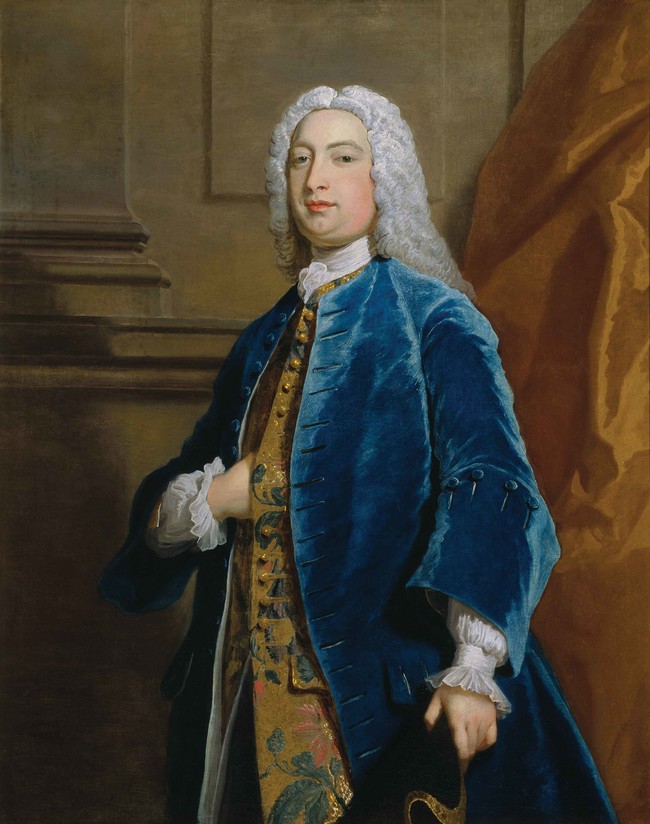
Joseph Highmore Thomas Budgen, Esq., M.P. for Surrey 1751–61 1735. Oil on canvas. Collection of Christchurch Art Gallery Te Puna o Waiwhetū, purchased 1977






